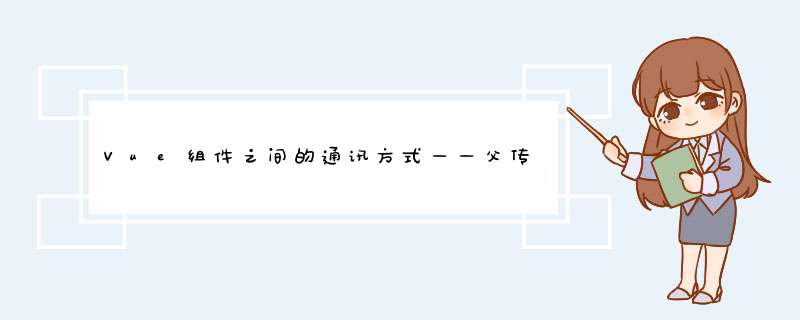
目录
一、父传子
1、props 属性传递
2、方法传递
3、 $parent获取方法和属性
二、子传父
1、 属性传递
2 、通过$refs主动获取子组件方法和属性
3 、通过$children主动获取子组件方法和属性
三、兄弟间的通讯
1 、通过共同的父亲进行传递信息
2、全局事件总线—EventBus
3、 通过PubSub通讯
4 、通过Vuex通讯
组件之间传值通讯分为三种: 父传子、子传父、兄弟组件之间的通讯;
前提
这里我们使用了vue/cli4使用默认配置常见的项目,详情 点击创建好项目之后我们需要这样做
在components的文件夹下新建名为Parent.vue和ChildOne分别充当父组件和子组件。然后在App.vue和Parent.vue中映射成组件标签
基本结构如下Parent.vue
Parent
ChildOne.vue
ChildOne
一、父传子 1、props 属性传递
父组件通过自定义属性给子组件传值,子组件用props接收
代码如下
Parent.vue
//template
Parent
// script
data () {
return {
msg:'i am you father'
}
},
ChildOne.vue
//template
ChildOne
接收到父亲传来的消息:{{msgToChild}}
//script
export default {
//第一种写法
// props:['msgToChild']
//第二种写法
props: {
msgToChild: {
type: String,
}
}
};
通过组件标签进行方法的传递,子组件$emit触发方法
父组件:Parent.vue
//template
//script
methods:{
/*定义方法*/
showMsg () {
alert('i am your father')
}
},
子组件:ChildOne.vue
//tempalte
接收到父亲传来的消息:{{msgToChild}}
//script
props:{
/*接收方法*/
methodToChild:{
type:Function
}
},
methods:{
/*触发方法*/
needFatherMethod () {
this.$emit('methodToChild')
}
}
通过$parent来获取父组件的实例,从而获取父组件的属性和方法
子组件:ChildOne.vue
//template
/*定义后去父组件实例的方法*/
$parentMethod (){
console.log(this.$parent._data.msg)//i am you father
console.log(this.$parent.msg)//i am you father
this.$parent.showMsg()//调用方法
}
二、子传父 1、 属性传递
通过触发父组件的方法进行传递数据
这等同于父 ===> 子 传递方法,方法的参数就是子组件的数据,emit的第二个参数就是父组件想要的数据
缺点
需要一定的触发条件
不是响应式数据
一般触发条件只能在子组件,因为要得到的是子组件的数据(比如说在父函数定义一个方法通过这种方式来的到子组件数据,似乎比较困难。但是可以通过生命周期函数在子组件触发来传递数据)
父组件:Parent.vue
//template
接收到子组件传来的消息: {{childMsg}}
//script
data () {
return {
childMsg:''
}
},
/*1.定义得到子组件数据的方法,触发条件只能在子组件
* 2.在data中定义一个属性来保存子组件传递过来的数据
* */
getChildMsg (childMsg){
this.childMsg = childMsg
},
子组件:ChildOne.vue
//template
//script
data (){
return {
/*子组件数据*/
msg:'i am your child'
}
},
/*触发父组件的方法,并传递参数*/
setParentMsg (){
this.$emit('getChildMsg',this.msg)
},
2 、通过
$refs主动获取子组件方法和属性
通过ref得到子组件的实例,进而得到子组件的方法和属性
父组件:Parent.vue
//template
这是孩子的信息: {{childMsg}}
//script
data () {
return {
childMsg:''
}
},
/*得到子组件的方法和属性*/
getMyChildMsgAndMethod (){
this.childMsg = this.$refs.myChild.msg
this.$refs.myChild.methodToParent()
},
子组件:ChildOne.vue
//script
/*父亲调用的方法*/
methodToParent (){
alert('i am you child')
},
3 、通过
$children主动获取子组件方法和属性
通过this.$children得到的是一个子组件实例的数组
$refs相同
父组件:Parent.vue
//template
这是孩子的信息: {{childMsg}}
//script
$childrenMsg (){
/*this.$children得到是一个数组*/
const child = this.$children[0]
this.childMsg = child.msg
child.methodToParent()
},
三、兄弟间的通讯 1 、通过共同的父亲进行传递信息
父组件只充当邮递员的角色
他所利用的就是,父子和子父之间的通讯,两者的结合 在components文件夹下,新建ChildTwo.vue文件,代码如下
子组件:ChildTwo.vue
//template
ChildTwo
{{commonMsg}}
//script
export default {
props:['common-msg'],
name: "ChildTwo",
}
子组件:ChildOne.vue
//template
//script
data (){
return {
/*定义数据*/
commonMsg:'i love you ,my brother'
}
},
props:{
//接收父亲传来的方法,主要用于拿到此组件的数据
poster:{
type:Function
},
},
/*调用方法传递数据*/
setBrotherMsg (){
this.$emit('poster',this.commonMsg)
},
父组件:Parent.vue
//template
//script
data () {
return {
//定义保存数据的变量
commonMsg:''
}
},
methods:{
/*定义拿到数据的方法*/
poster (commonMsg){
this.commonMsg = commonMsg
},
}
2、全局事件总线—EventBus
EventBus相当于全局的$emit,$on
//eventBus原理就是利用和emit 并实例化一个全局 vue 实现数据共享
//main.js
Vue.prototype.$bus=new Vue()
//传值组件
this.$bus.$emit('eventTarget','值')
//接收组件
this.$bus.$on('eventTarget',value=> console.log(value))PubSub是一个包,专门用于组件之间的通讯
使用PubSub.subsribe()订阅(注册)事件
使用PubSub.publish()触发事件
他与event-bus的使用差不多,只是参数略有不同,绑定事件的第一个参数必须传(请看下面的例题)
一般在React中用的较多
使用
下载npm install pubsub-js --save
2.在ChildOne.vue引入
兄弟组件:ChildOne.vue
//template
//script
import PubSub from 'pubsub-js'
methods: {
pubsubBrotherMsg (){
PubSub.subscribe('pubsubMsg',this.commonMsg)
},
}
2.在ChildTwo.vue引入
兄弟组件:ChildTwo.vue
import PubSub from 'pubsub-js'
data(){
return {
pubsubMsg:''
}
},
mounted() {
/*msg:回调函数第一个参数,必须传*/
PubSub.subscribe('pubsubMsg',(msg,data) => {
this.pubsubMsg = data
} )
}
Vuex是一个集中式的状态管理
详情请看:
几分钟明白Vuex的五大属性和使用方法https://blog.csdn.net/m0_64346035/article/details/124618468
欢迎分享,转载请注明来源:内存溢出

 微信扫一扫
微信扫一扫
 支付宝扫一扫
支付宝扫一扫
评论列表(0条)